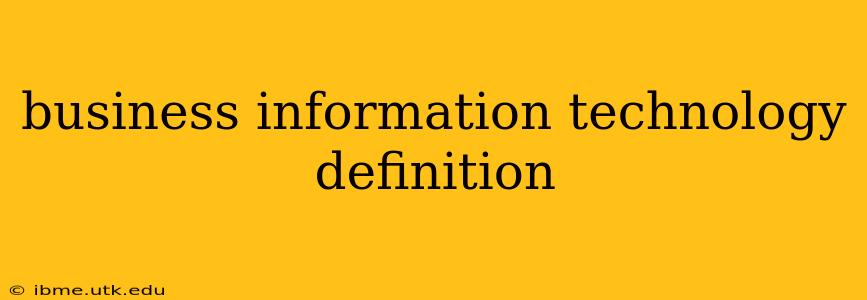Business Information Technology (IT) encompasses the application of computers and telecommunications equipment to support business operations, goals, and objectives. It's far more than just computers and software; it's a strategic resource that drives efficiency, innovation, and competitive advantage in today's digital world. This definition includes the planning, development, implementation, and management of computer systems, networks, and databases, all designed to streamline processes, improve decision-making, and ultimately increase profitability.
What are the core components of Business Information Technology?
Business IT isn't a single entity but rather a collection of interconnected elements working in harmony. These core components include:
- Hardware: This encompasses all the physical components of a computer system, such as desktops, laptops, servers, printers, routers, and storage devices. The choice of hardware depends heavily on the specific needs of the business.
- Software: This includes operating systems, applications, databases, and other programs that run on the hardware. Software dictates how the hardware is used to achieve specific business goals. Examples include CRM (Customer Relationship Management) software, ERP (Enterprise Resource Planning) systems, and specialized industry-specific applications.
- Data: This is the lifeblood of any business IT system. It includes all the information collected, processed, and stored by the system. Effective data management is crucial for successful business operations. This often involves structured data in databases and unstructured data like emails and documents.
- Networks: These connect all the hardware and software components together, allowing for communication and data sharing within the organization and with external partners. This includes local area networks (LANs), wide area networks (WANs), and the internet.
- People: This is often the most overlooked component. Business IT relies heavily on skilled professionals—system administrators, developers, network engineers, data analysts, and cybersecurity experts—to design, implement, maintain, and secure the entire system.
- Processes: This refers to the defined workflows and procedures that govern how information is handled and processed within the IT system. Efficient processes are crucial for optimizing operations.
- Security: Protecting the IT infrastructure and data from unauthorized access, use, disclosure, disruption, modification, or destruction is paramount. Security measures are vital for maintaining business continuity and protecting sensitive information.
What are the key functions of Business Information Technology?
Business IT plays a crucial role in several key functions:
- Improving operational efficiency: Automating tasks, streamlining workflows, and optimizing processes lead to significant cost savings and increased productivity.
- Enhancing decision-making: Access to real-time data and advanced analytics enables businesses to make informed decisions based on facts and insights.
- Boosting innovation: IT facilitates the development and implementation of new products, services, and business models.
- Improving customer relationships: CRM systems and other customer-facing technologies enhance customer service and satisfaction.
- Strengthening competitiveness: Businesses that leverage IT effectively gain a significant competitive advantage in the marketplace.
- Supporting collaboration: IT facilitates communication and collaboration within the organization and with external partners.
How does Business IT support different business functions?
Business IT permeates all aspects of a modern organization. Here are some examples:
- Finance: Managing financial data, forecasting, budgeting, and reporting.
- Marketing: Customer relationship management (CRM), marketing automation, social media marketing, and analytics.
- Sales: Lead generation, sales force automation, and customer relationship management.
- Human Resources: Payroll, recruitment, employee management, and training.
- Operations: Supply chain management, production planning, and inventory control.
What are the challenges faced in Business Information Technology?
Despite its benefits, Business IT also presents challenges:
- Cost: Implementing and maintaining IT systems can be expensive.
- Security: Protecting IT systems and data from cyber threats is a constant challenge.
- Complexity: Modern IT systems are highly complex and require skilled professionals to manage.
- Change management: Implementing new IT systems can require significant changes to business processes and employee workflows.
- Keeping up with technology: The rapid pace of technological change requires continuous investment in training and upgrades.
What is the future of Business Information Technology?
The future of Business IT is constantly evolving, driven by advancements in areas such as:
- Artificial intelligence (AI): AI is transforming business processes by automating tasks, improving decision-making, and enhancing customer experiences.
- Cloud computing: Cloud-based solutions offer greater scalability, flexibility, and cost-effectiveness.
- Big data and analytics: Analyzing large datasets enables businesses to extract valuable insights and make data-driven decisions.
- Cybersecurity: With increasing cyber threats, robust cybersecurity measures are crucial for protecting business data and operations.
- Internet of Things (IoT): Connecting devices and systems creates new opportunities for data collection and automation.
In conclusion, Business Information Technology is a dynamic and crucial component of modern business operations. Understanding its core components, functions, and challenges is vital for any organization striving for success in today’s increasingly digital world.
